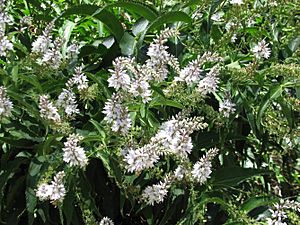Derwent speedwell facts for kids
Quick facts for kids Derwent speedwell |
|
|---|---|
 |
|
| Scientific classification | |
| Genus: |
Veronica
|
| Species: |
derwentiana
|
| Synonyms | |
|
|
Veronica derwentiana, commonly known as Derwent speedwell, is a pretty flowering plant. It belongs to the Plantaginaceae family, which includes many well-known garden plants. You can find this plant growing naturally in south-eastern Australia. It's a plant that lives for many years (a perennial). It has leaves with small teeth and lovely white or pale blue flowers. These flowers grow in clusters at the top of the stems during spring and summer.
Contents
What Does Derwent Speedwell Look Like?
Derwent speedwell is a plant that grows like a woody herb. This means it has stems that are a bit woody, but it's not a tree or a shrub. It can grow quite tall, up to about 140 centimeters (that's almost 5 feet!). It has many straight stems that grow from a strong, woody base underground.
The stems can be smooth or have tiny hairs. They can last for up to two years. The leaves are long, from 5 to 20 centimeters. They are shaped like a spear or an egg and have a sharp point at the end. The bottom part of the leaf can be shaped differently, like a wedge or a heart. Some leaves have a small, wide stalk, while others have no stalk at all. Each leaf has many small, pointed teeth along its edges, usually between 30 and 80 of them.
The flowers are very pretty. They have small green parts called calyx lobes, which are about 2 to 5 millimeters long. These can be smooth or have a few short hairs. The flower petals themselves are about 5 to 9 millimeters long. They can be white, light purple, or pale blue. These flowers grow in long clusters called racemes, with 40 to 100 flowers in each cluster.
After the flowers bloom, the plant produces a seed capsule. This capsule is shaped like a narrow or wide egg, about 2.8 to 5.5 millimeters long and 2.5 to 4.5 millimeters wide. It can be smooth or have short hairs on its top side, and it often looks a bit shiny. Derwent speedwell usually flowers during the summer months.
How Derwent Speedwell Got Its Name
Naming the Plant
The plant Veronica derwentiana was first officially described in 1808. This description was made by a person named Henry Cranke Andrews. He published his findings in a book called The Botanist's Repository for New and Rare Plants.
The plant was given the name derwentiana because it was first found near the Derwent River in Tasmania. So, its name tells us where it was discovered!
Different Types of Derwent Speedwell
Scientists have found that there are actually five slightly different types, or subspecies, of Derwent speedwell. These are all recognized by the Australian Plant Census, which keeps track of all the plants found in Australia. Each subspecies has its own unique scientific name, but they are all part of the same Veronica derwentiana species.
Where Derwent Speedwell Lives
Its Home in Australia
Derwent speedwell grows in many different places across south-eastern Australia. You can find it in Queensland, New South Wales, Victoria, Tasmania, and South Australia.
It likes to live in various environments. For example, it can be found in eucalypt forests, which are forests filled with eucalyptus trees. It also grows in alpine herb fields, which are open areas with many small plants found in cooler, higher mountain regions. You might also see it growing in "disturbed sites." These are places where the ground has been changed by humans or natural events, like roadsides or areas where land has been cleared.

